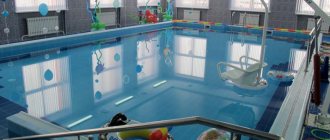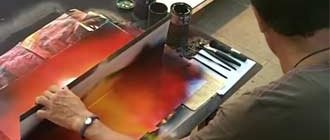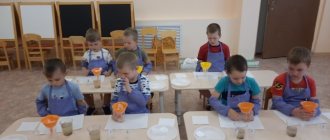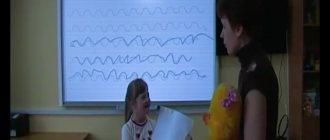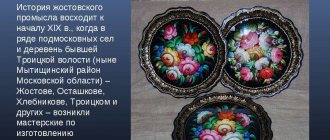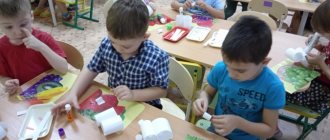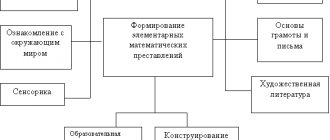Swimming lesson summary for preschool age
Summary of a lesson on teaching swimming to a kindergarten group.
Target:
- Arouse interest in swimming.
- Promote healing and hardening as much as possible.
Tasks:
1. Familiarization with the rules of behavior in the pool and safety precautions. 2. Develop hygiene skills. 3. Develop motor skills. 4. Develop physical qualities: speed, strength, agility.
The training session is divided into three parts: preparatory, main, final. Part 1: preparatory
.
Includes formation, greeting, roll call, communication of lesson objectives, theoretical material, preparatory exercises on land and in water. In this part of the lesson, in addition to the organizational function, the task of preparing the child’s body for the upcoming physical activity is solved. Part 2: main
.
The main task of the lesson is solved, new material is studied. The skills and abilities acquired in previous classes are consolidated and physical qualities are developed. Part 3: final.
Solves the problem of restoring the functional systems of the child’s body after exercise. It uses breathing exercises, relaxation, low-intensity games, and independent swimming. In the final part of the lesson, a roll call is held, summing up the results of the lesson.
Progress of the lesson.
Preparatory part. On land: I.p. The main stance is walking in place, raising your knees high. I.p. basic stance – arms to the sides, up, stretch, look up, stand on tiptoes, arms to the sides, down. I.p. standing, hands on the belt - squats, arms forward. I.p. standing with your feet apart, hands on your belt - bend over, touching the floor with your hands, without bending your knees.
In the water: Walking along the side, holding the handrail with one hand, scooping up the water with the other, “little and big legs.” Standing with your back to the side, make “rain” and “waves” with your hands. Standing facing the side, holding the handrail with your hands, jumping out of the water (who is taller?).
Main part. Moving along the bottom by walking and running using rowing movements with your arms. Standing facing the side, take one step back, sit down in the water up to your shoulders, stretch your arms straight forward, grab the handrail with your hands, and “fountain” with your feet. Immerse yourself in water. Hold breath; perform a chest slide with a “board” in your hands, using the crawl style footwork. Game exercises with diving “magic hoop”; “starfish”, “float”, “divers”. Outdoor game "Fishes are frolicking."
Final part. Game exercises: “Divers”, “Bubbles”.
Exit from the water.
MAGAZINE Preschooler.RF
Synopsis of a swimming lesson. Senior group. Theme: "Goldfish"Physical education instructor at MADOU kindergarten No. 10 Vitkalova I.S. Kanevskaya, Krasnodar region.
Goal: promoting a healthy lifestyle, developing creative abilities in children.
Software tasks:
- consolidate swimming skills and abilities: crawl legwork when swimming on the front and back, with a swimming board; elements of breaststroke swimming technique; coordination of movements when swimming in a non-sports manner
- develop coordination of movements when performing exercises in water
- consolidate elements of water aerobics, hydroplastics and synchronized swimming in musical compositions; develop the ability to perform exercises synchronously
- develop agility, speed and overall endurance
- train the breathing muscles
- help prevent flat feet and poor posture
- cultivate courage; kindness, responsiveness to someone else's misfortune; give every child the opportunity to feel like they belong to a close-knit group of like-minded people; improve children's environmental culture
- bring joy to children and create a good mood.
Materials for the lesson: stereo system, CD with soundtrack
V. Shainsky to the song “Chunga-Changa” , music by M. Dunaevsky to the song “Vodyany” from the cartoon “The Flying Ship” , music of Andrei Petrov’s waltz from the film “Beware of the Car” ; costumes of postman Pechkin, Vodyanoy, rubber toys (frog, duck, heron); an envelope with a letter from Neptune, a mini aquarium with a swimming fish; swimming boards, small inflatable balls (8 pcs), sinking toys (crayfish - 5 pcs), two baskets with floating objects (tennis balls, disposable plastic dishes, small rubber balls - “jumpers” , plastic cubes, etc.).
Progress of the lesson.
Instructor:
Good morning, have a wonderful day! We gathered as if for a holiday. Isn't it nice for the kids to play with me in the water?
Children: Yes!
There's a knock on the door.
Instructor:
Hush, kids, what kind of knock suddenly came on our door? Who is rushing towards us so carelessly?
The postman enters - Pechkin.
Hello, yes this is Pechkin!
Pechkin: I have a letter for you -
Get it!
He hands over the letter and leaves.
Instructor:
The postman was in a hurry for good reason - he brought the news from the king of the sea. He wouldn’t bother us just like that, Something terrible happened, maybe?
Opens and reads the letter. “I, Neptune, the Lord of the sea, strike you with my brow and mourn: the merman, the scoundrel, stole
My goldfish. But fresh water is so harmful for the baby! Help out, help!
Save the fish quickly. The river inhabitants will help you find the right path!”
INSTRUCTOR: Shall we help the Lord of the Sea?
Children: Yes!
Instructor:
Then - good luck! We start with the pond! Get into the water quickly and find your places.
We imitate movements, Imitating, in exercises.
At the instructor's signal, the children perform the exercises.
1. Imitating a boat with oars, Leaning towards the water, We walk and row our hands through the water. Game exercise “Boats with oars” : walking along the bottom, helping with rowing movements of the hands.
2. Walk like ducks in a half-squat in the water. Dive more often, blow more bubbles.
Game exercise “Ducks and dives” : walking along the bottom in a half-squat, alternating inhalation and exhalation into the water, plunging headlong under the water.
3. Imitating frogs, Jump - splash, jump - splash, Jump cheerfully, my friend!
Game exercise “Frogs are funny” : from a crouching position, jump forward on two legs and squat again.
A toy appears in the hands of the instructor - L yushka. He imitates the voice of a frog.
Frog:
Hello, croak - croak, friends! I will show you the way, Which will lead to Vodyanoy. But first we’ll gain strength -
Let's all exercise together.
Children line up first - second and line up in two lines
Take the balls in order, Look, listen, understand
And repeat after the frog!
The music of V Shainsky sounds on the song “Chunga - changa” . Children perform a hydroaerobics complex with a ball “Exercising the Frogs” .
1. “The little frogs woke up and stretched”.
IP: standing, arms with the ball extended forward. Raise your arms straight up, stretch on your toes (4 times).
I.p.: standing, hands with the ball behind the head. Straighten your arms up, stretch on your toes (4 times).
2. “The little frogs are squatting, stretching their legs”.
I.p.: standing, hands with the ball behind the head. Straighten your arms forward, squat, spreading your knees and feet to the sides (4 times).
I.p.: standing, hands with the ball in front of the chest. Straighten your arms forward, squat (4 times).
3. "The frogs turn and look around"
I.p.: standing, hands with the ball behind the head. Turn the body right - left (4 times in each direction).
I. p.: standing, hands with the ball in front of the chest. Turn the body to the right - left with straightening the arms in the direction of the turn (4 times in each direction).
4. “The little frogs are squatting again, stretching their legs”.
I.p.: standing, hands with the ball in front of the chest. Straighten your arms forward, squat, spreading your knees and feet to the sides (4 times).
5. “The little frogs bend over and are called tumblers.”.
I.p.: standing, arms with the ball extended upward. Tilt the body to the right - left (4 times in each direction).
I.p.: standing, hands with the ball behind the head. Tilt the body to the right - left (4 times in each direction).
6. “The baby frogs lean forward as if they are worshiping a heron.”.
I.p.: standing, hands with the ball behind the head. Bend your torso forward, lower your face into the water (4 times).
I.p.: standing, hands with the ball behind the head. Straighten your arms forward, tilt your torso forward, lower your face into the water (4 times).
7. “The frogs blow bubbles and pretend to be a pump.”
I.p.: standing, arms with the ball extended upward. Squats with exhalation into the water (4 times).
I.p.: standing, hands with the ball behind the head. Squats with exhalation into the water (4 times).
8. “The little frogs are having fun, jumping, spinning”.
I.p.: standing, hands with the ball in front of the chest. Jump on the right leg, then on the left leg (4 times each).
I.p. standing, hands with the ball in front of the chest. Jumping on two legs 4 times with a turn to the right (360 degrees).
8. "The little frogs are resting and playing with a ball".
I.p.: hands with the ball in front of the chest. Walking in place while restoring breathing.
IP: walking in place, arms extended to the sides, ball in one hand - inhale. While walking in place, raise your arms straight up, transfer the ball to the other hand - exhale.
Children line up in one line and pass the balls.
Frog:
Well done, brothers! Should we swim breaststroke? The frog style is eternal - We won’t swim to the river with it!
1 task:
With breaststroke on your chest, swim to the side. Bend your legs, straighten them, and glide through the water.
Exercise: sliding on the chest with breaststroke footwork, holding the breath.
Task 2:
Hands breaststroke on your chest Glide through the water. Hands bent to the sides, brought forward together,
Together we swim to the signal.
Exercise: sliding on the chest with breaststroke, holding the breath.
Task 3:
Coordinate movements We learned during classes in the water. Hands - breaststroke, legs - crawl, Swimming is convenient for children.
Exercise: sliding on the chest with coordination of movements of the arms in breaststroke and legs in freestyle, holding the breath.
Frog: We got to the river together.
To you, kids,
It's time to look for other helpers.
Farewell!
A toy appears in the instructor’s hand - a tak.
Duck:
Quack, quack, quack, guys! How do you swim okay! The frog whispered to me: “You really need to see Vodyanoy?”
And the clue is carried by a river crayfish at the bottom. You can catch him quickly - Duck - dive!
Sinking toys (crayfish) are lowered to the bottom in advance. There is a note attached to one of the crayfish - a hint.
Duck-dive game .
Children dive headfirst, trying to find crayfish at the bottom of the pool. At the same time, both legs bent at the knees are raised - “showing the tail .
One of the children takes out a crayfish from the bottom, to which a note with a hint is attached.
INSTRUCTOR: (Unfolds the note and reads it loudly)
“You need to swim on your chest and on your back with a board in your hands. Move rhythmically and quickly with your legs and crawl together.”
Exercise: swimming on the front and on the back with a board: the legs work like a crawl in coordination with breathing.
A toy appears in the hands of the instructor - a claw. He imitates the voice of an old heron.
T a p l i:
I've been living in a swamp for a long time! Nobody just walks around here. Did you come for the golden fish? Barely alive, exhausted,
She can hardly breathe without sea air.
Are you ready to help?
Children: Yes.
T a p l i:
You breathe like a “pump” Game exercise “Pump” . Standing in a line with their backs to the side, at a signal, children exhale repeatedly into the water.
the “Vodyanoy Song” from the cartoon “The Flying Ship” plays .
Water appears.
Water:
I am the Lord of the swamps, and accordingly I will become. But why do I want to fly - No one cares about that.
That’s why I’m angry and harmful and completely unscrupulous. So I’ll take it and eat a goldfish for lunch!
Instructor:
What are you, what are you, Vodyanoy! Are you that bad? Remember how Ivan the Wonderful helped build a ship!
You didn't get enough sleep, guess? Wait a minute to eat the fish! Let's figure out what's going on here. What are you tired of here?
Water:
Look what's going on - They've muddied up all the water: Flasks, jars, rags, krinkas, Even torn shoes!
Who wants to get into such rubbish for the whole day? There is no one left here, even the fish have fled.
Instructor:
Stop - why are you scolding - We will clean up all the water! We'll collect the garbage in no time - the swamp will become a lake!
Game "Collect garbage" .
The pool water area is divided in half by a dividing path. Accordingly, the children are divided into two teams and lined up along one of the sides. of “garbage” (disposable plastic tableware, tennis balls, cubes and other floating objects) is randomly scattered from the baskets onto the water area of each team At the signal, the children of both teams quickly collect “garbage” into their baskets standing on the opposite side. The team that collects “its trash” first wins.
Water:
Respected, thank you, Vodyanoy. Are you ready for other tests? I’ll give you the fish, so be it, But you’ll have to swim through the tunnel!
Game exercise “Swim through the tunnel” . Four children form a tunnel from two hoops. The rest of the children line up in a column one at a time. At a signal, children take turns performing a front slide with crawl footwork through a tunnel of vertically held
hoops, trying not to touch the hoop.
Water:
Oh yes, children, that’s how they are masters! The water in the lake has become clean! The fish are coming back - it’s nice for them to frolic in the clean!
Should I introduce you to the fish?
Children: Yes!
Water: Can you name which ones without difficulty?
Children call fish.
Instructor:
The fish are dancing in the pond - their tails are twisting and twisting! How our children dance. Do you want to take a look at Vodyany?
Accept a gift from them -
Dance of the goldfish!
A waltz sounds to the music of A. Petrov from the movie “Beware of the Car” . Children perform dance movements with elements of synchronized swimming, hydroplasty (wave-like movements of the arms from right to left, from top to bottom, tilting the body back, squats; “float” with a “star” ; formation in a circle facing each other, holding hands at the top, backs to each other with arms around the waist, bending the body back and forth facing into the water, walking at an extended step with a half-squat in one direction and the other; “ float” - “arrow” ; turning around in a circle facing each other; performing wave-like movements arms with the torso tilted back and squatting).
Water:
How light and clear my soul is! I haven't rested for a long time. I’m very glad to make friends with you, I saw sympathetic guys,
Clever, brave, generous and attentive, and so talented in the water! Here's a fish for you, and go with God. Well, I'll go take a little nap.
The merman gives the instructor a mini-aquarium with a swimming fish, says goodbye to the children and leaves.
Children come up to the side and look at “golden” fish.
Instructor:
Children, acting deftly and boldly, you did a good deed: you returned the goldfish to Neptune, you helped the Vodyanoy a little.
The tests passed all marvelously, thank you very much for that! It's time for us to say goodbye, See you again in the water, friends!
The lesson is over. One by one, the children climb the stairs out of the water.
Literature.
- Osokina T.I., Timofeeva E.A., Bogina T.L. Swimming lessons in kindergarten. M., 1991.
- Pishchikova N.G. Swimming training for preschool children. M., 2008.
- V.S. Vasiliev. Teaching children to swim. M., 1989.
- S.V. Yablonskaya, S.A. Cyclis. Physical education and swimming in kindergarten. M., 2008.
- M.D. Makhaneva, G.V. Baranova. Figure swimming in kindergarten. M., 2009.
| Next > |
Fun in the pool in the junior group of kindergarten. Abstract
Plan of entertainment in the pool for children 3-4 years old “Guests from the swamp.”
Equipment: swimming rings, houses (glued to the sides), small frogs, a frog-shaped swimming board. Goal: creating conditions for the development of skills and abilities of motor activity in water. Objectives: 1. To consolidate the skill of moving in water in various directions, 2. To teach complete immersion in water. 3. Develop attention. 4. Develop the ability to play together, follow the rules of the game Duration: 15 min. Instructor: Hello, guys! Children: Hello! Instructor: Today we have guests for our lesson! The instructor shows a large frog board and little frogs (sitting on the board). Instructor: Who is this, guys? Children: Frogs! Instructor: Can you jump like frogs? Children: Yes! Children jump around the pool in all directions (2 min.). Instructor: Quaaaah! Guys, do you hear? The frogs want us to show them our pool! Shall we show? Children: Yes! Children take one small frog at a time, put on swimming rings and begin to slide (push off from the bottom with their feet) in loose water, while holding the frogs between their palms on outstretched arms, their legs straighten back after pushing off. The instructor shows the correct sliding and hand position. If necessary, tell the children that they need to show each side (right, left, far, near). Instructor: Guys, the frogs are tired and want to rest. Where do we put them to rest? Children: On the side (on the mother frog, etc.). children put frogs on a board or side. Instructor: Children, do you want to show the frogs, while they are resting, how we can still play in the water? Children: Yes! Instructor: Let's play the game “Sunshine and Rain”! Guys, who else lives in water, swims in it, glides? Children: Fish (dolphins, etc.) Instructor: Correct! At the signal “Sun”, we put on swimming rings and begin to jump like frogs or swim like fish (your choice). At the signal “Rain”, we all run and get up to the houses (of different colors, glued on the sides). Sun! Children begin to swim or jump around the pool in loose water (1 min.). Instructor: Rain! The children get up to the houses. The game is repeated 3 times. Instructor: Well done, guys! Everyone quickly hid in their houses! I wonder how frogs play in their swamp? Shall we ask them? Children: Yes! How do you play in the swamp? Instructor (frog): Kwaaa! We love to play hide and seek! Instructor: Children, where can you hide in our pool? Children: Into the water! Instructor: I suggest we all play hide and seek together, don’t you agree? Children: Yes! Instructor: Frogs want to be drivers! Do you agree? Let's count to three: one, two, three! The instructor begins to push the board with frogs across the water, the children hide when the frogs approach. The game is repeated 3 times. Instructor: The frogs didn’t find Katya and Sasha, they were the best at hiding! Instructor (frog): Quaaaah! Thank you guys! We really enjoyed your stay! We will definitely come again! And now it’s time for us to go home in the boooooooooooooooooooooooooooooooooooooooooooooooooooooooooooooooooooooooooooooooooooooooooooooooooooooooooooooooooooooooooooooooooooooooooooooooooooooooooooooooooooooooooooooooooooooooooooooooooooooooooooooooooooooooooooooooooooooooooooooooooooooooooooooooooooooooooooooooooooooooooo Goodbye! Children: Goodbye! Instructor: Children, did you like playing with frogs? Children: Yes! Instructor: Then, we will definitely invite them to visit again. Our lesson has come to an end. It's time to get out of the pool!
We recommend watching:
Musical entertainment for children of the 2nd junior group. Scenario Physical education leisure “Journey to Lesovichka” Russian folk games in physical education lessons Preservation of physical and mental health in children with mental retardation during physical education
Similar articles:
Scenario of musical entertainment “In a flower meadow” for the younger group of kindergarten
